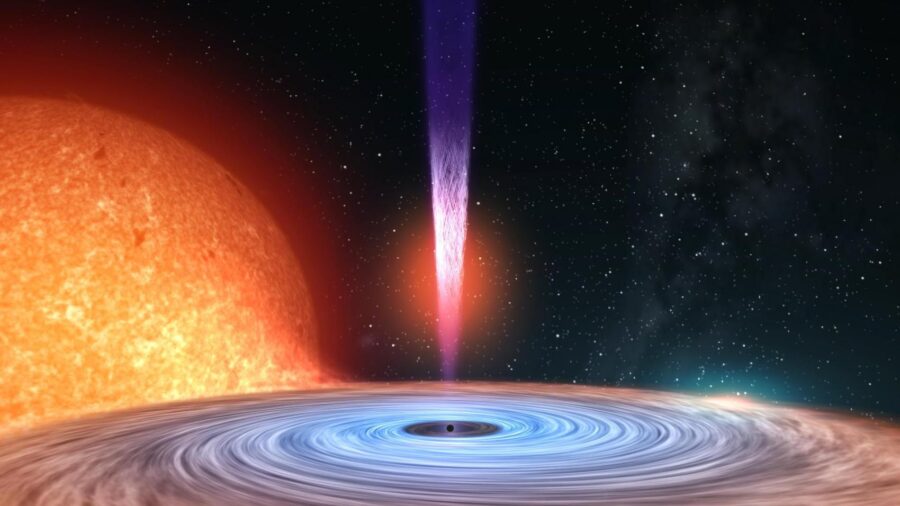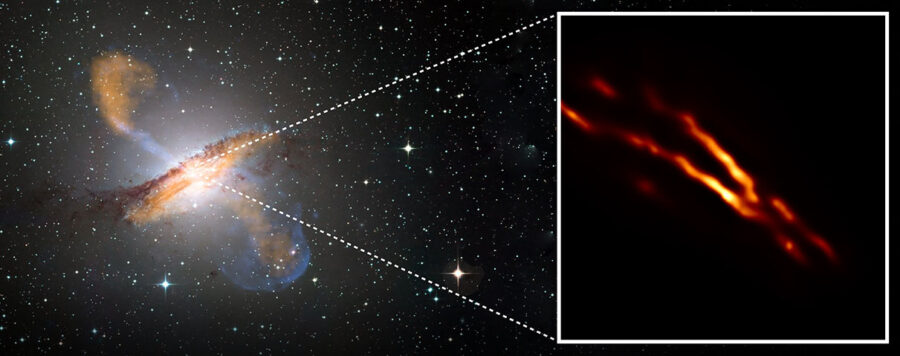Astronomers have watched a jet launch from a stellar-mass black hole, shedding light on how these structures form.
When X-rays flared from an area of the sky previously thought to be empty in March 2018, they triggered an early alert system. Astronomers around the world stopped what they were doing to turn six telescopes, including one aboard the International Space Station, toward the flare.
In the resulting observations, which ranged from radio to X-rays, Alex Tetarenko (Texas Tech University) and her collaborators caught something never seen before: the creation and launching of jets from a black hole, named MAXI J1820+070, about 10,000 light-years away in our galaxy. With observations in hand, they calculated physical properties of the jet, such as its distance and motion relative to the black hole.
“Jet materials alter the chemistry of interstellar gas and affect galaxy and star formation,” Tetarenko explains. “They also provide laboratories to test fundamental physics, so understanding what causes them is so important.”
Black Hole Jets

Gabriel Pérez Díaz (Instituto de Astrofísica de Canarias)
Most of the black holes we’ve discovered inside our galaxy have been detectable because they have a stellar companion. As a black hole pulls matter from its companion, the matter spirals inward, losing energy and emitting X-rays, just before entering the maw.
Jets then erupt from the black hole’s poles, propelling particles with such concentrated force that they fly out at relativistic speeds to light-years away, emitting radio waves that can be detected from Earth.
Astronomers have observed jets around black holes large and small — recently, for example, the Event Horizon Telescope captured sharp images of jets from the supermassive black hole M87*. But questions remain as to jets’ origins. Namely, where does all the jet-launching power come from?

Radboud University; ESO / WFI; MPIfR / ESO / APEX / A. Weiss et al.; NASA / CXC / CfA / R. Kraft et al.; EHT / M. Janssen et al.
There are two competing theories: The jets could be extracting energy and angular momentum from the magnetic fields that thread the spinning black hole’s event horizon, or magnetic fields anchored in the materials swirling into the black hole could provide the needed power.
In order to answer these questions, we need to watch a full cycle to see a jet launch and extinguish. Stellar-mass black holes offer this opportunity because they run through an entire cycle in a few months, instead of taking millions of years as supermassive black holes do.
Mapping the Jet
MAXI J1820 flared when it caught an extra gob of gas from its stellar companion, which is about half the mass of the Sun. The team measured the outburst across a broad spectrum of wavelengths from X-rays to radio waves. Using a timing analysis method, they were finally able to resolve the tiny details of MAXI’s jets.
“The technique . . . is analogous to how ships use sonar to map underwater objects,” explains Tetarenko, “Except here, we use the timing signals propagating from inflow to outflow as ‘black hole sonar’ to map the jet structures.”
Timing analysis revealed the base height of the jets, their angle, and speed. This is important since properties like the magnetic field strength depend highly on the geometry.

X-ray: NASA / CXC / University of Paris / M. Espinasse et al.; Optical / IR: PanSTARRS
Calculations showed that MAXI J1820’s jets launched a mere light-second (300,000 km) away from the black hole, about 1,000 times closer than Earth is to the Sun. So close to the black hole, the jets are extremely narrow, opening at just 0.45 degrees, the narrowest angle measured to date.
Based on these results, published in the Astrophysical Journal, Andrzej Zdziarski (Polish Academy of Sciences), Tetarenko, and Marek Sikora (also at Polish Academy of Sciences) think the black hole might be responsible for powering the jet. The energy the jet carries is consistent with theoretical predictions from the black hole spin scenario, Tetarenko says.
Tetarenko expects that deeper investigations into the data, as well as observations of more black hole systems, will help confirm the result.
“By simultaneously studying how the emission of the black hole X-ray binary changes from one part of the electromagnetic spectrum to another, Alex and her collaborators succeed in accurately measuring something that has never been possible in the past to this precision,” notes Sara Motta (University of Oxford, UK), who wasn’t involved in the study. “This is crucial to constrain the fundamental physics ruling the jet generation and launching mechanism.”
 2
2









Comments
Cousin Ricky
November 30, 2021 at 3:27 pm
The illustration you have labeled M87* is actually of Centaurus A.
https://eventhorizontelescope.org/blog/eht-pinpoints-dark-heart-nearest-radio-galaxy
You must be logged in to post a comment.
Monica Young
November 30, 2021 at 6:47 pm
Right you are, this is fixed now.
You must be logged in to post a comment.
You must be logged in to post a comment.